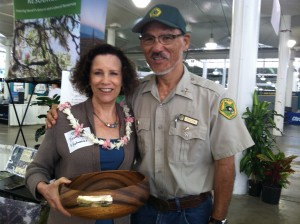Kaulunani, Hawaii’s Urban And Community Forestry Program Receives Sustainability Award For Hawaii-Pacific Weed Risk Assessment
Posted on Nov 8, 2013DEPARTMENT OF LAND AND NATURAL RESOURCES
News Release
| NEIL ABERCROMBIE GOVERNOR |
WILLIAM J. AILA JR,
CHAIRPERSON |
For Immediate News Release November 8, 2013
KAULUNANI, HAWAII’S URBAN AND COMMUNITY FORESTRY PROGRAM
RECEIVES SUSTAINABILITY AWARD FOR
HAWAII-PACIFIC WEED RISK ASSESSMENT

Teresa Trueman-Madriaga, Kaulunani manager (left) accepts the LICH award, with Wayne Ching (right), DLNR protection forester.
Click to download a PDF of this news release
HONOLULU — The Kaulunani Urban and Community Forestry Program was recently awarded the PlantPono/Invasive Plants Advocacy Award from the Landscape Industry Council of Hawaii for having the vision to support the Hawaii-Pacific Weed Risk Assessment, which has transitioned from being a UH research project to one of the Hawai‘i Invasive Species Council’s key prevention projects.
“Kaulunani functioned as a non-biased voice to look at how a weed risk assessment would be valuable as a decision-making tool in our state,” said Christy Martin, public information officer for the Coordinating Group on Alien Pest Species. “They brought in the resources necessary to fund the initial work, and used their relationships with industry to open the dialog.”
Kaulunani is a federally funded urban forestry program of the Department of Land and Natural Resources (DLNR) Division of Forestry and Wildlife, and is operated by the non-profit organization Friends of Hawaii’s Urban Forest (dba Smart Trees Pacific.)
The Hawaii-Pacific Weed Risk Assessment was developed to help identify plants that pose a high weed risk in Hawaii and on other Pacific islands and is widely used and recognized as one of the primary measurement systems predicting invasive plant probability across all ecosystems in Hawaii.
In 2001, Kaulunani hosted a gathering of urban foresters, botanists, conservationists and educators to discuss the relationship between invasive species in urban areas and wild land areas. This collaborative working group recommended an integrated course of action to reduce the negative impacts of invasive species on the native ecosystems.
By the time this urban forestry project was completed in 2004, more than 600 plants had been analyzed and given a weed risk score. To date, 1,486 plant species have been screened using the Weed Risk Assessment.
The Weed Risk Assessment continues to have an ever-increasing significance for the health of forests in urban and conservation lands. A subsequent tool, the Plant Pono website, was created as a companion education and outreach component. Together they make this valuable information available to an audience that also includes landscapers, homeowners and developers.
Kaulunani’s leadership and funding helped create the foundation for this primary information source used today to protect our urban, conservation and coastal lands from invasive plant introductions.
“Both the conservation community and the landscape industry are the two communities most likely impacted by the continued use and widespread adoption of the weed risk assessment and the desire to ‘Plant Pono,’ ” said Charles Chimera, a Weed Risk Assessment specialist with the Hawaii Invasive Species Council.
“If we can prevent the introduction of the next Miconia, the next fireweed, or the next fountain grass, potentially every community in the islands would benefit—whether you value native ecosystems, are a farmer or rancher trying to make a living, or are a resident living in an area prone to fire,“ Chimera said.
Conservation leaders and land managers are a natural audience for use of the Weed Risk Assessment and Plant Pono website. Hawaii Landscape Industry Council members are also key adopters of the system.
Of the 378 assessment requests received from January 2012 to October 2013, 15 percent were from private individuals, 47 percent were from industry-related groups (landscape, nursery, botanical gardens, etc.), and the remaining 38 percent were from conservation groups or government agencies who use this in planning their land management strategies. The Plant Pono website is currently adding components that will allow easier access and dialogue for homeowners and gardeners.
For more information about Kaulunani’s programs and cost-share grants please contact: Jolie Wanger, (808) 395-7765; [email protected]
# # #
Media Contacts:
Teresa Trueman-Madriaga
Kaulunani Urban Forestry Program
Phone: (808) 672-3383
[email protected],
Deborah Ward
Public information specialist
Phone (808) 587-0320
[email protected]
